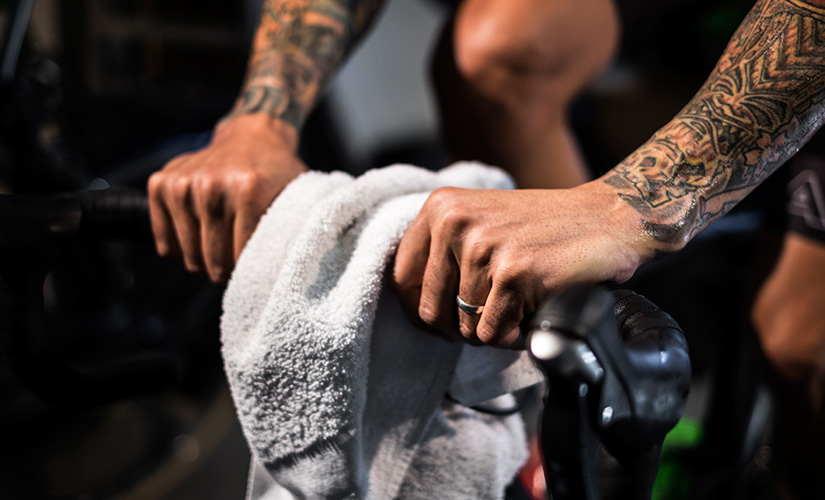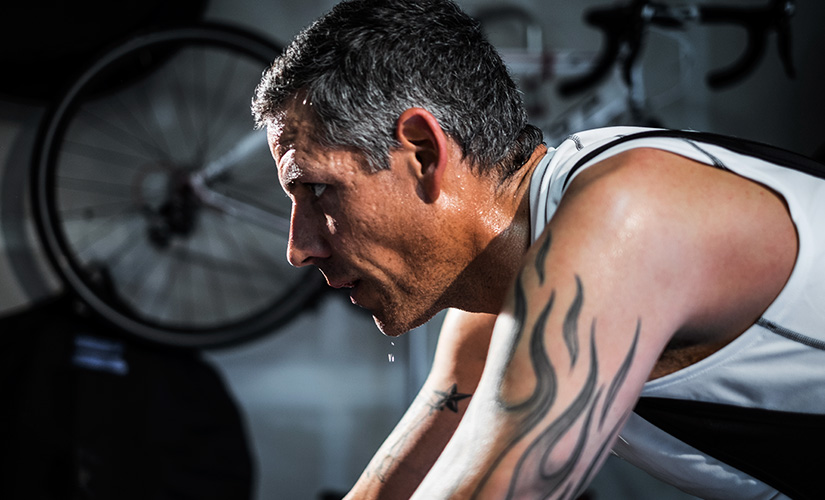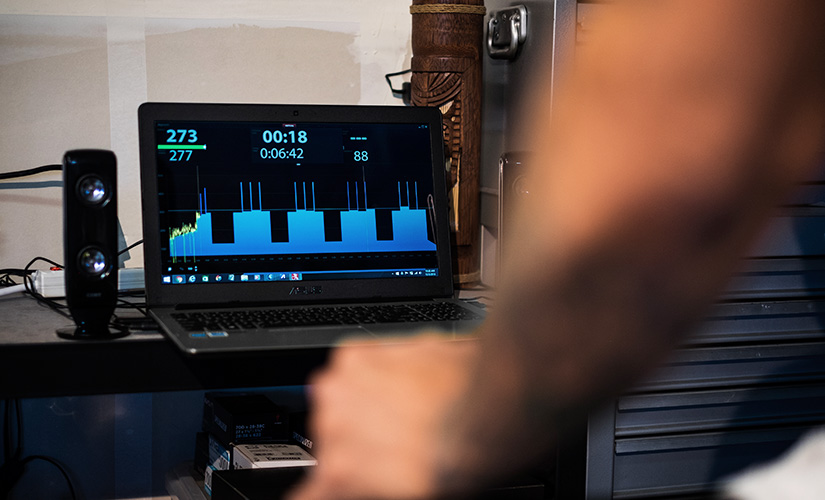How Aging Athletes Can Get Faster (Yes It’s Possible)
Let’s cut to the chase: if you’re not seeing improvements within your season as an aging athlete, adjustments must be made.
This is keeping in mind that training, and thereby training adaptation, is cyclical in nature. So the magnitude of improvements will be largely dependent on what level of athlete you already are. Nonetheless, there are things to keep in mind to properly balance your physiological age as an athlete who’s getting a little older.
Our physiological age has proven to be much different than the number of years we’ve been on the planet. How is it that certain athletes have been able to maintain high levels of performance despite their increasing age? Genetics — sure, certainly influence things, but not nearly as much as the thought-out adjustments made to their structured training.
What’s holding you back?

Before tackling the roadblocks that may be limiting your performance, you need to first know your body. As an aging athlete, signs of incipient illness, lingering injury, and general health concerns must be recognized and acted upon immediately. Otherwise, it’ll be impossible to effectively work towards maintaining your ability to perform as you notice some extra grey hairs.
That disclaimer aside, if you’ve been able to avoid major health issues and injuries as an aging athlete, we have good news: the odds are stacked in your favor. You can get still get faster. Drawing on observations made in Mike Studer’s 2016 article for Topics in Geriatric Rehabilitation, the following discussion highlights the idea that although age is irreversible, performance trends for aging athletes are on an upward trend.
Factors That Can Decrease Performance As We Age
Age
Status quo maintains that as we get older, we get weaker, and our ability to perform decreases exponentially. At a certain age this is nearly always the case, but many longitudinal research studies have proven the opposite. Block periodization in high-intensity interval training, proper doses of strength training, and correct recovery regimens have significantly slowed the process of getting weaker as we age, and in certain scenarios, reversed signs to varying extents.
Diminishing strength
The loss of muscle mass as we age is known as sarcopenia. We know that the decline in hormone production (testosterone, human growth hormone, insulin-like growth factor) attributes to a significant loss of muscle mass. We also know that a decline in hormone production is directly tied to a decline in strength training.
Common belief has it that as we get older, we’re simply meant to do less; carry less weight, exert less energy, and be all-around less active. Due to this way of thinking, our strength training loads have decreased with our age, and so has our muscle mass. As we lose the denser muscle mass, we replace it with increased body fat.
This begs the question: Is our decline in muscle mass due to a decline in strength training, and thus a decline in hormone production that helps maintain and develop the muscles? If so, you must ask yourself: Is my lack of strength training due to impending injury, incipient illness, or general health concerns? Or have I simply stopped doing as much activity because popular belief is that I’m supposed to slow down? If you’re healthy and not seeing improvements within your season’s training, it’s likely the only thing holding you back is yourself.
Decreased aerobic capacity (VO2 max)
Revisiting our discussion on VO2 max, we know that a part of the aerobic undertaking is the ability for our bodies to uptake and deliver oxygen to the muscles in order to produce energy. Now we must consider what may be in the way of your bodies ability to do that.
As we age, our VO2 max declines. If we’re training properly, that decline may be somewhere in the neighborhood of .25% – 1% per year. Many point to general declines in the oxygen-carrying power of the blood, capillary density, aerobic enzymatic activity in the muscles, mitochondrial proliferation, and overall lung capacity as the culprits. Also frequently faulted: stroke volume — the amount of blood that’s pumped with each heartbeat — and max heart rate, both of which are also commonly on a downward trend as we get older. Interestingly enough, as our activity slows so does our max heart rate. This is possibly due to our bodies once being used to pumping larger amounts of blood; and now as we’ve become increasingly sedentary, the left ventricle isn’t challenged to work as hard, thus becoming less capable of its former blood-pumping glory. This is something to keep in mind in our discussion on how to slow, or even reverse these effects.
Increasing body fat
As we get older, we’re more prone to gaining weight. This isn’t some random phenomena; science has explained the physiological processes that are occurring here. That said, there is an inverse relationship with your increasing body fat, and your decreasing aerobic capacity that needs to be noted. Remember, your VO2 max is a function of your oxygen over your weight; so even if the numerator stays the same (volume of oxygen in mL), the increase in your body weight (in kilograms) will have an adverse effect on your aerobic capacity. Basically you have more weight to move, despite a stagnant capacity for oxygen delivery. The outcome is decreased performance reflected simply going slower.
Increased body fat is largely attributed to individual diet and lifestyle, but also physiological changes that coincide with aging for all people. Lipoprotein lipase (LPL) is an enzyme that, among other things, is responsible for storing fat in adipose tissue. LPL accumulates in areas like the belly and above our hips which are common areas of ‘flabbiness’. This process is regulated by testosterone which we know to be on the decline towards our late 40s and 50s.
Another major factor that must be kept in mind with fat accumulation is the increase in insulin production. The introduction of carbohydrates or sugars causes insulin levels to rise, which can also promote the fat storing ability of LPL. As bleak as things are sounding at this point, further research holds more good news: frequent exercise increases testosterone and the body’s sensitivity to insulin production which helps maintain proper balance of LPL’s fat storing for normal biological processes.
How can we act on these limiters?

By this point, our discussion has pointed out some negative realities that you, as an aging athlete, have been facing or may one day experience. The areas they may be impacting your performance is largely individual to your biological makeup and how you live your life. Therefore, this discussion is meant to make it clear what may be limiting your performance; thus allowing you to identify what you think you need to change. Now we’ll move into some general ways to act on those limiters.
Ways to Get Stronger and Faster As An Aging Athlete
High-Intensity Interval Training
Aerobic capacity eventually decreases — simple as that. But at which rate is what we’re able to control. The best way to control aerobic capacity from decreasing is via the application of high-intensity interval training stress. Aerobic capacity and subsequently lactate threshold, are two indicators of performance that have proven to be positively affected by this type of training. This is validated in studies that prove declines in VO2 max occur at far more rapid rates when athletes begin to phase out higher intensity training and replace it with more endurance training. Furthermore, high-intensity interval training involving periodic strength stress has proven to increase androgenic hormone production like testosterone that limits the fat storing LPL to an optimal rate.

Strength Training
Ideally, as aerobic capabilities slowly decline, our hopes are to place an emphasis on maintaining or increasing our strength. As long as there aren’t any serious joint/tendon/bone issues holding you back, it’s a good idea to get back into sport-specific muscle building by strength training. Recent evidence even validates the ability to increase strength well into your 80s!
When we shift away from strength training as we age, like popular convention leads us to do, our type II fast-twitch muscle fibers can begin to take on more qualities of type I slow-twitch fibers. Why? Because that’s the exact type of endurance work most athletes turn to as they age. Although this may help in slow, long-distance endurance activity, studies have shown that LSD training is the exact type of activity that does little-to-nothing to preserve declining aerobic capacity. This is because you’re no longer challenging your body to push your limits of aerobic capacity and aerobic-specific muscles.
Recovery Strategies
Recovery, especially as an aging athlete, is arguably just as important as training stress. We already know this is how training adaptation occurs (i.e. supercompensation), and the only way to complete the puzzle is to allow for the adequate recovery required to perpetuate the upward trend in your fitness. The only way to do that is through a proper recovery process. There are two key players that determine how well your body recovers: sleep and nutrition. Leaving out either largely contributes to the decline in our performance.
- Sleep — Sleep is where the majority of recovery takes place. Growth hormone and testosterone, among other hormones, are both released at specific levels of sleep, which allows our bodies to adapt to the manipulations we’ve made to it. Unfortunately, as we get older the ability to achieve those required levels of sleep becomes difficult. Dialing in a consistent sleep schedule can help our aging bodies reach the deeper levels of sleep required for proper recovery.
- Nutrition — Diet is yet another key player in a recovery strategy. As important as it is, it’s another one of those factors that has to be decided on an individual level. A diet rich in carbohydrates or a diet with high fats and proteins are usually the two options athletes choose from. If you’re finding the more dated method of predominantly carbohydrates as a source for fuel isn’t working, start making the conscious decisions to shift your macronutrient balance more toward fats/proteins.
Still No Gains? Try Small Changes
As aging athletes, we need to recognize when we’re totally gassed from a week of workouts and make the necessary adjustments. Those adjustments may include:
- Your week of workouts doesn’t have to be seven days. If you’re struggling to make gains, your body probably needs more recovery to allow more adaptation. Add the extra days of rest while maintaining the rest of your intensity. You’ll then need to adjust your training plan accordingly.
- Doing your training sessions in the morning? When your Thursday session rolls around, has the fatigue from Tuesday’s heavy workout worn off yet? If not, try pushing that workout to an evening ride instead. Sometimes just a few extra hours of rest makes the difference. Any more adjusting may call for you to increase your ‘week’ of workouts.
- The typical training plan TrainerRoad’s Head Coach Chad Timmerman designs includes three weeks on with one week of active recovery or taper. Feel free to manipulate this; Chad’s plans are designed to be flexible. Maybe two weeks on with one week off will better suit the adaptation capabilities of your body. You can simply swap week three and four, then repeat that recovery week again in lieu of week six’s planned week.
- Maybe the active recovery sessions during the recovery weeks are still too much work. If this is the case, slip in some days where you’re completely off the bike, and perhaps it won’t be necessary to make any adjustments to your plan.
Keep in mind your training should be structured to consider three things: duration, frequency and intensity. These practices need to be monitored carefully as we get older, but research has proven if you find this training to be too stressful, it’s best to reduce duration or frequency — but not intensity.
Keep an Eye Out
Our bodies are absolutely capable of adapting in a positive way to achieve higher performance in endurance sports as we age. So while we may feel like we’re getting older, it’s more than likely our bodies are still capable of maintaining high levels of performance. That doesn’t mean you shouldn’t be aware of potential signs you’re pushing your limits. Always be sure to allow for the type of recovery that suits your body best.
For more answers to your cycling training questions, listen to our podcast Ask a Cycling Coach — the only podcast dedicated to making you a faster cyclist. New episodes are released weekly.
